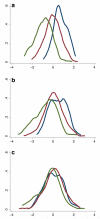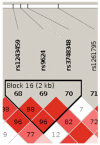Genetic architecture of resilience of executive functioning
- PMID: 22711244
- PMCID: PMC3607298
- DOI: 10.1007/s11682-012-9184-1
Genetic architecture of resilience of executive functioning
Abstract
The genetic basis of resilience, defined as better cognitive functioning than predicted based on neuroimaging or neuropathology, is not well understood. Our objective was to identify genetic variation associated with executive functioning resilience. We computed residuals from regression models of executive functioning, adjusting for age, sex, education, Hachinski score, and MRI findings (lacunes, cortical thickness, volumes of white matter hyperintensities and hippocampus). We estimated heritability and analyzed these residuals in models for each SNP. We further evaluated our most promising SNP result by evaluating cis-associations with brain levels of nearby (±100 kb) genes from a companion data set, and comparing expression levels in cortex and cerebellum from decedents with AD with those from other non-AD diseases. Complete data were available for 750 ADNI participants of European descent. Executive functioning resilience was highly heritable (H² = 0.76; S.E. = 0.44). rs3748348 on chromosome 14 in the region of RNASE13 was associated with executive functioning resilience (p-value = 4.31 × 10⁻⁷). rs3748348 is in strong linkage disequilibrium (D' of 1.00 and 0.96) with SNPs that map to TPPP2, a member of the α-synuclein family of proteins. We identified nominally significant associations between rs3748348 and expression levels of three genes (FLJ10357, RNASE2, and NDRG2). The strongest association was for FLJ10357 in cortex, which also had the most significant difference in expression between AD and non-AD brains, with greater expression in cortex of decedents with AD (p-value = 7 × 10⁻⁷). Further research is warranted to determine whether this signal can be replicated and whether other loci may be associated with cognitive resilience.
Figures





Similar articles
-
Dysexecutive and amnesic AD subtypes defined by single indicator and modern psychometric approaches: relationships with SNPs in ADNI.Brain Imaging Behav. 2012 Dec;6(4):649-60. doi: 10.1007/s11682-012-9207-y. Brain Imaging Behav. 2012. PMID: 23161456 Free PMC article.
-
Assessment of Demographic, Genetic, and Imaging Variables Associated With Brain Resilience and Cognitive Resilience to Pathological Tau in Patients With Alzheimer Disease.JAMA Neurol. 2020 May 1;77(5):632-642. doi: 10.1001/jamaneurol.2019.5154. JAMA Neurol. 2020. PMID: 32091549 Free PMC article.
-
Genome-wide analysis of genetic predisposition to Alzheimer's disease and related sex disparities.Alzheimers Res Ther. 2019 Jan 12;11(1):5. doi: 10.1186/s13195-018-0458-8. Alzheimers Res Ther. 2019. PMID: 30636644 Free PMC article.
-
The executive prominent/memory prominent spectrum in Alzheimer's disease is highly heritable.Neurobiol Aging. 2016 May;41:115-121. doi: 10.1016/j.neurobiolaging.2016.02.015. Epub 2016 Feb 21. Neurobiol Aging. 2016. PMID: 27103524 Free PMC article.
-
The LDLR locus in Alzheimer's disease: a family-based study and meta-analysis of case-control data.Neurobiol Aging. 2007 Jan;28(1):18.e1-4. doi: 10.1016/j.neurobiolaging.2005.11.005. Epub 2005 Dec 27. Neurobiol Aging. 2007. PMID: 16378661 Review.
Cited by
-
Cognitive Resilience to Alzheimer's Disease Pathology in the Human Brain.J Alzheimers Dis. 2019;68(3):1071-1083. doi: 10.3233/JAD-180942. J Alzheimers Dis. 2019. PMID: 30909217 Free PMC article.
-
Role of testosterone and Y chromosome genes for the masculinization of the human brain.Hum Brain Mapp. 2017 Apr;38(4):1801-1814. doi: 10.1002/hbm.23483. Epub 2017 Jan 10. Hum Brain Mapp. 2017. PMID: 28070912 Free PMC article.
-
Neuroimaging Feature Terminology: A Controlled Terminology for the Annotation of Brain Imaging Features.J Alzheimers Dis. 2017;59(4):1153-1169. doi: 10.3233/JAD-161148. J Alzheimers Dis. 2017. PMID: 28731430 Free PMC article.
-
FASTKD2 is associated with memory and hippocampal structure in older adults.Mol Psychiatry. 2015 Oct;20(10):1197-204. doi: 10.1038/mp.2014.142. Epub 2014 Nov 11. Mol Psychiatry. 2015. PMID: 25385369 Free PMC article.
-
Over-expression of heat shock protein 70 protects mice against lung ischemia/reperfusion injury through SIRT1/AMPK/eNOS pathway.Am J Transl Res. 2016 Oct 15;8(10):4394-4404. eCollection 2016. Am J Transl Res. 2016. PMID: 27830023 Free PMC article.
References
-
- Barrett JC, Fry B, Maller J, Daly MJ. Haploview: analysis and visualization of LD and haplotype maps. Bioinformatics. 2005;21(2):263–265. doi:10.1093/bioinformatics/bth457. - PubMed
-
- Centers for Disease Control and Prevention. Alzheimer’s Association . The healthy brain initiative: a national public health road map to maintaining cognitive health. Alzheimer’s Association; Chicago: 2007.
Publication types
MeSH terms
Grants and funding
- K01 AG030514/AG/NIA NIH HHS/United States
- R01 AG019771/AG/NIA NIH HHS/United States
- P50 AG05136/AG/NIA NIH HHS/United States
- P30 AG10133/AG/NIA NIH HHS/United States
- P30 AG010133/AG/NIA NIH HHS/United States
- CAPMC/ CIHR/Canada
- P30 AG013846/AG/NIA NIH HHS/United States
- P50 AG005136/AG/NIA NIH HHS/United States
- R01 AG029672/AG/NIA NIH HHS/United States
- R01 AG032990/AG/NIA NIH HHS/United States
- R01 AG19771/AG/NIA NIH HHS/United States
- P30 AG010129/AG/NIA NIH HHS/United States
- P30 AG019610/AG/NIA NIH HHS/United States
- R13 AG030995/AG/NIA NIH HHS/United States
- P50 AG016574/AG/NIA NIH HHS/United States
- K99 LM011384/LM/NLM NIH HHS/United States
- U01 AG024904/AG/NIA NIH HHS/United States
- U19 AG010483/AG/NIA NIH HHS/United States

